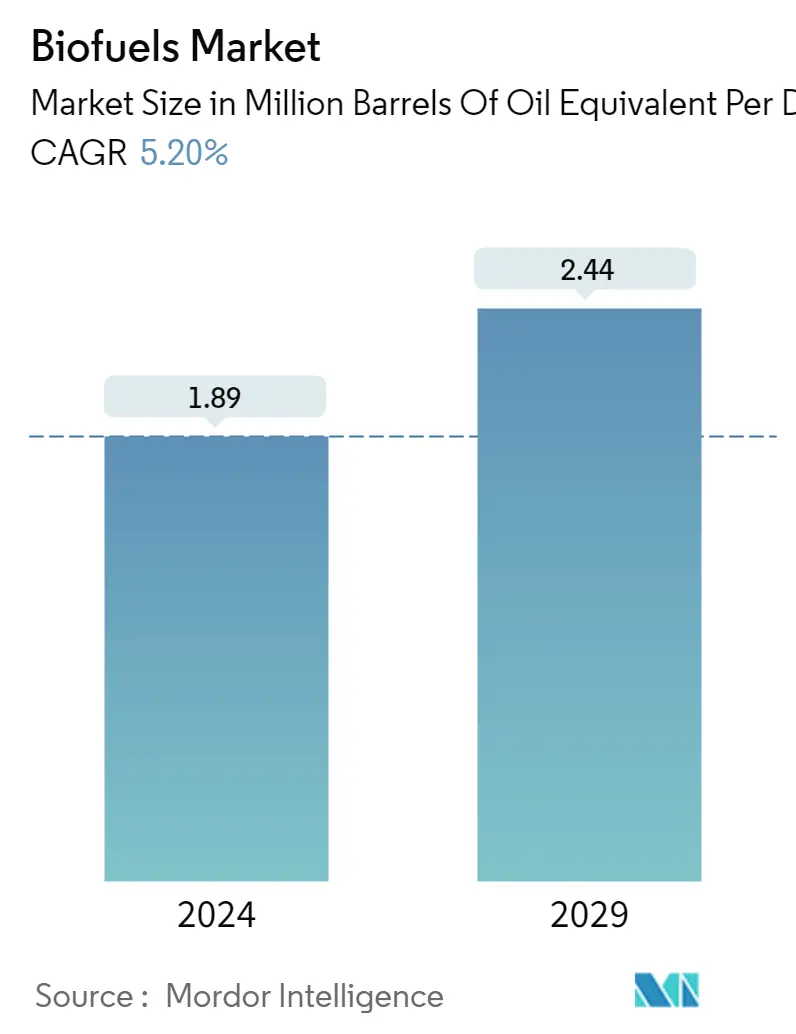Market Size of Biofuels Industry

| Study Period | 2020 - 2029 |
| Base Year For Estimation | 2023 |
| CAGR (2024 - 2029) | 5.20 % |
| Fastest Growing Market | Asia Pacific |
| Largest Market | North America |
| Market Concentration | Low |
Major Players
*Disclaimer: Major Players sorted in no particular order |
Biofuels Market Analysis
The Biofuels Market size is estimated at 1.89 Million barrels of oil equivalent per day in 2024, and is expected to reach 2.44 Million barrels of oil equivalent per day by 2029, growing at a CAGR of 5.20% during the forecast period (2024-2029).
- Over the medium term, the increasing demand for secure, sustainable, and clean energy coupled with government mandates for increasing blending in automotive fuels is expected to propel the demand for biofuels across the globe.
- On the other hand, the high cost of production of biofuels, even with all the benefits associated with them, is likely to restrain the growth of the market.
- Nevertheless, with the recent technological advancements, the production of biofuels has increased, which is going to act as an opportunity for the market's expansion.
- North America dominates the market, and it is likely to witness the highest CAGR during the forecast period. The growth is attributed to the rapid increase in production facilities coupled with the increase in demand for biofuels in the region.
Biofuels Industry Segmentation
Biofuels usually refer to liquid fuels and blending elements produced from biomass materials called feedstocks. Most biofuels are used as transportation fuels, but they may also be used for heating and electricity generation. Due to its replenishable attributes, biofuel is considered a renewable energy source. It is affordable and an alternative to petroleum or other fossil fuels. It can be used as an energy source for vehicles and industrial applications.
The biofuel market is segmented by type, feedstock, and geography. By type, the market is segmented into biodiesel, ethanol, and other types. By feedstock, the market is segmented into palm oil, jatropha, sugar crop, coarse grain, and other feedstock. The report also covers the market size and forecasts across major regions. The market size and forecasts for each segment have been made based on volume.
| Fuel Type | |
| Ethanol | |
| Biodiesel | |
| Other Fuel Types |
| Feedstock | |
| Palm Oil | |
| Jatropha | |
| Sugar Crop | |
| Coarse Grain | |
| Other Feedstock |
| Geography | ||||||
| ||||||
| ||||||
| ||||||
| ||||||
|
Biofuels Market Size Summary
The biofuels market is poised for significant growth over the forecast period, driven by increasing global demand for secure, sustainable, and clean energy sources. Government mandates for blending biofuels with traditional automotive fuels are expected to further propel market expansion. Despite the high production costs associated with biofuels, technological advancements have enhanced production capabilities, presenting opportunities for market growth. North America is anticipated to lead the market, benefiting from a surge in production facilities and rising demand for biofuels in the region. The transportation sector's push towards reducing greenhouse gas emissions is also a key factor, with biofuels like ethanol emerging as a cleaner alternative, particularly in regions with stringent renewable energy norms.
Globally, countries such as India, Brazil, and Indonesia are implementing blending mandates to boost biofuel usage, while initiatives in the United States and Canada are providing regulatory and financial support to enhance biofuel adoption. Notable developments, such as Brazil's removal of import tariffs on ethanol and significant investments in biofuel infrastructure in the United States, are expected to drive market growth. The North American region, with its robust aviation market and established transportation infrastructure, is likely to dominate the biofuels market, supported by government policies and production capacity. The market remains fragmented, with major players like Archer Daniels Midland Company, Abengoa Bioenergy SA, and POET LLC actively contributing to its development through strategic projects and partnerships.
Biofuels Market Size - Table of Contents
-
1. MARKET OVERVIEW
-
1.1 Introduction
-
1.2 Biofuel Production Historic and Forecast, till 2028
-
1.3 Biofuel Consumption Historic and Forecast, till 2028
-
1.4 Recent Trends and Developments
-
1.5 Government Policies and Regulations
-
1.6 Market Dynamics
-
1.6.1 Drivers
-
1.6.1.1 Increasing Demand for Secure, Sustainable, and Clean Energy
-
-
1.6.2 Restraints
-
1.6.2.1 High Cost of Production of Biofuels
-
-
-
1.7 Supply Chain Analysis
-
1.8 Industry Attractiveness - Porter's Five Forces Analysis
-
1.8.1 Bargaining Power of Suppliers
-
1.8.2 Bargaining Power of Consumers
-
1.8.3 Threat of New Entrants
-
1.8.4 Threat of Substitute Products and Services
-
1.8.5 Intensity of Competitive Rivalry
-
-
-
2. MARKET SEGMENTATION
-
2.1 Fuel Type
-
2.1.1 Ethanol
-
2.1.2 Biodiesel
-
2.1.3 Other Fuel Types
-
-
2.2 Feedstock
-
2.2.1 Palm Oil
-
2.2.2 Jatropha
-
2.2.3 Sugar Crop
-
2.2.4 Coarse Grain
-
2.2.5 Other Feedstock
-
-
2.3 Geography
-
2.3.1 North America
-
2.3.1.1 United States of America
-
2.3.1.2 Canada
-
2.3.1.3 Rest of North America
-
-
2.3.2 Europe
-
2.3.2.1 Germany
-
2.3.2.2 United Kingdom
-
2.3.2.3 Denmark
-
2.3.2.4 Rest of Europe
-
-
2.3.3 Asia-Pacific
-
2.3.3.1 China
-
2.3.3.2 India
-
2.3.3.3 Indonesia
-
2.3.3.4 Rest of Asia-Pacific
-
-
2.3.4 South America
-
2.3.4.1 Brazil
-
2.3.4.2 Argentina
-
2.3.4.3 Chile
-
2.3.4.4 Rest of South America
-
-
2.3.5 Middle-East and Africa
-
2.3.5.1 United Arab Emirates
-
2.3.5.2 Saudi Arabia
-
2.3.5.3 South Africa
-
2.3.5.4 Rest of Middle-East and Africa
-
-
-
Biofuels Market Size FAQs
How big is the Biofuels Market?
The Biofuels Market size is expected to reach 1.89 million barrels of oil equivalent per day in 2024 and grow at a CAGR of 5.20% to reach 2.44 million barrels of oil equivalent per day by 2029.
What is the current Biofuels Market size?
In 2024, the Biofuels Market size is expected to reach 1.89 million barrels of oil equivalent per day.

